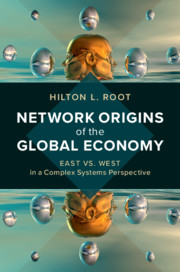Book contents
- Network Origins of the Global Economy
- Network Origins of the Global Economy
- Copyright page
- Dedication
- Contents
- Figures
- Tables
- Contributors
- Preface
- Overview
- Acknowledgments
- Part I Political Economy and Complex Systems
- Part II An Analysis of Historical Regimes
- Part III The Coming Instability
- 7 Has the Baton Passed to China?
- 8 China’s Ambitions and the Future of the Global Economy
- 9 Global Networks over Time
- 10 A Future of Diminishing Returns or Massive Transformation?
- 11 Network Structure and Economic Change: East vs. West
- References
- Index
8 - China’s Ambitions and the Future of the Global Economy
from Part III - The Coming Instability
Published online by Cambridge University Press: 17 March 2020
- Network Origins of the Global Economy
- Network Origins of the Global Economy
- Copyright page
- Dedication
- Contents
- Figures
- Tables
- Contributors
- Preface
- Overview
- Acknowledgments
- Part I Political Economy and Complex Systems
- Part II An Analysis of Historical Regimes
- Part III The Coming Instability
- 7 Has the Baton Passed to China?
- 8 China’s Ambitions and the Future of the Global Economy
- 9 Global Networks over Time
- 10 A Future of Diminishing Returns or Massive Transformation?
- 11 Network Structure and Economic Change: East vs. West
- References
- Index
Summary
If China’s far-reaching market reforms make it the world’s largest economy, then another momentous shift in global dynamics may be under way – a change in the very structure of global capitalism – making the system of global trade and investment more compatible with the Chinese model. How will China’s version of state capitalism affect its trading partners? And will other countries be likely to adopt and adapt some of China’s policy innovations, making its experience a source of new variations in global governance? In the West, officials criticize China as a free rider on the stability of the political order that it treats with skepticism and which it is now trying to change to fit its own interests. But they are complacent in their confidence that a nexus between open markets and open polities is a universal feature of economic prosperity. A larger concern also looms: going global may transform China into a hub within a larger system, and a giant hub at that, but one that is not centrally positioned to control all others. The complexity of the global economy far exceeds the capability of the Chinese Communist Party as a controlling mechanism.
Keywords
- Type
- Chapter
- Information
- Network Origins of the Global EconomyEast vs. West in a Complex Systems Perspective, pp. 200 - 226Publisher: Cambridge University PressPrint publication year: 2020



